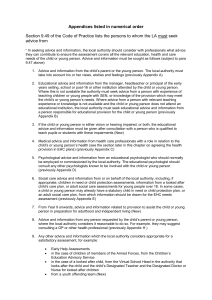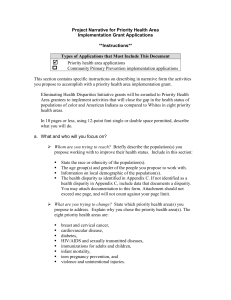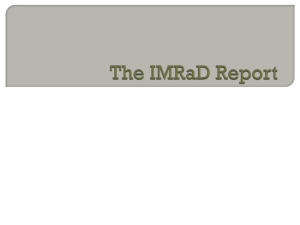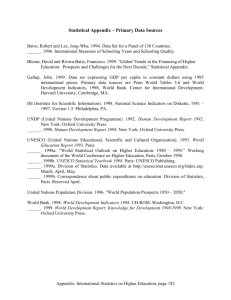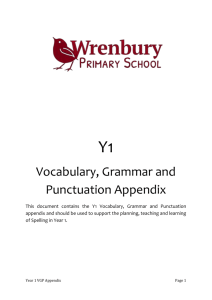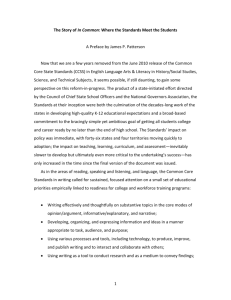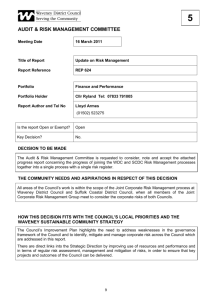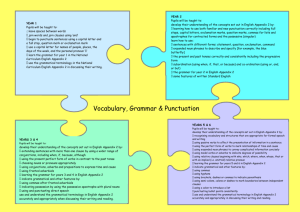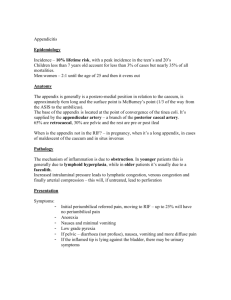Notes for Learning Outcomes session
advertisement
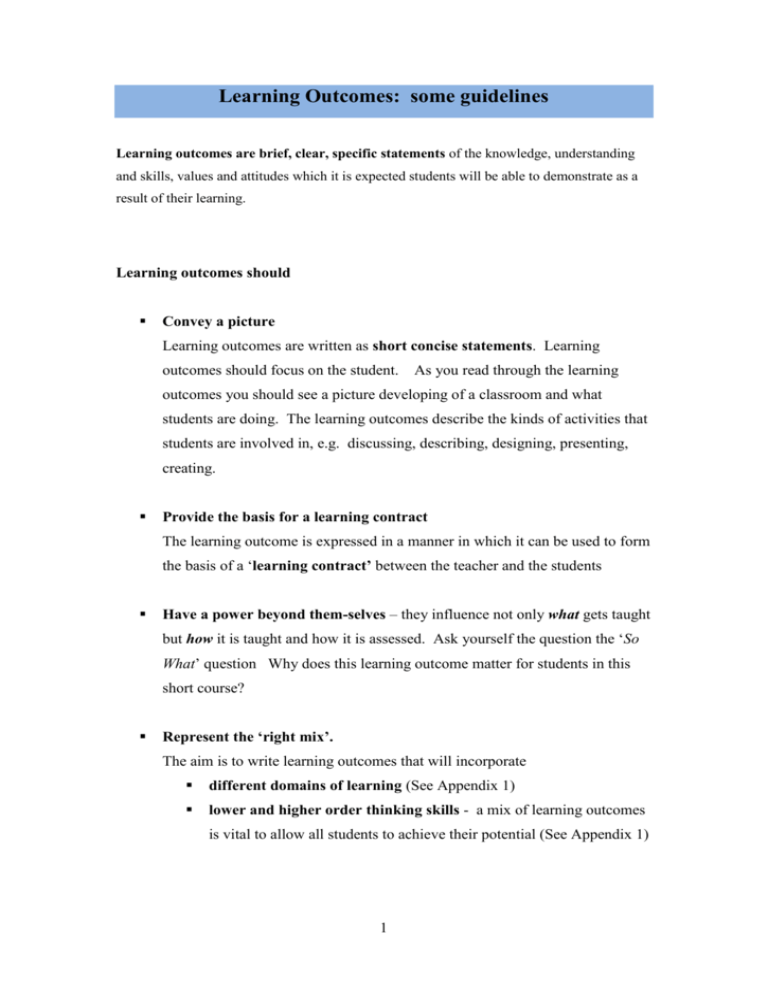
Learning Outcomes: some guidelines Learning outcomes are brief, clear, specific statements of the knowledge, understanding and skills, values and attitudes which it is expected students will be able to demonstrate as a result of their learning. Learning outcomes should Convey a picture Learning outcomes are written as short concise statements. Learning outcomes should focus on the student. As you read through the learning outcomes you should see a picture developing of a classroom and what students are doing. The learning outcomes describe the kinds of activities that students are involved in, e.g. discussing, describing, designing, presenting, creating. Provide the basis for a learning contract The learning outcome is expressed in a manner in which it can be used to form the basis of a ‘learning contract’ between the teacher and the students Have a power beyond them-selves – they influence not only what gets taught but how it is taught and how it is assessed. Ask yourself the question the ‘So What’ question Why does this learning outcome matter for students in this short course? Represent the ‘right mix’. The aim is to write learning outcomes that will incorporate different domains of learning (See Appendix 1) lower and higher order thinking skills - a mix of learning outcomes is vital to allow all students to achieve their potential (See Appendix 1) 1 Help identify what should be assessed in the short course What might be the kinds of evidence that students will be asked to gather and present as evidence of their learning? Reflect the appropriate Level indicators on National Framework for Qualification (Appendix 2) Remember LESS is MORE Keep learning outcomes short ( Giving examples or using ‘such as’ is not a good idea!) Don’t have too many learning outcomes – a maximum of four learning outcomes per topic in the strand Ask yourself if the learning outcome is really needed? It may not need to be explicitly stated. Everything the students will do and learn does not have to be stated as a learning outcome. For example, consider this learning outcome in a CSPE Short Course: ‘The student should be able to assemble a basic needs basket representing the needs of an average family unit’ In order to do this, the student will need to understand the difference between needs and rights. They will need to appreciate that needs do not mean the same thing to everybody. Three separate learning outcomes are not needed however. One well composed outcomes serves the same purpose. Avoid vague, general statements. Avoid verbs that are difficult to quantify such as know, study, learn, showan understanding of.., Avoid lower order learning outcomes such as recall, recite, list. Learning outcomes can be Content based – (analyse an historical event) Product based – (design a media campaign for …) 2 Process based – (conduct an experiment, conduct a role play) The Junior Cycle Key Skills The key skills must be embedded in the short course learning outcomes. Be familiar with the Key Skills Overview. Check out the Junior Cycle Key Skills Overview at www.juniorcycle.ie Read through the Overview and highlight the learning outcomes that are immediately relevant to your short course. You may not incorporate all of them but they will be a useful reference point when you are devising your learning outcomes. Make the Key Skills learning outcomes your own and adapt them to the particular learning context of the short course that you are developing. The following table includes some examples of how this can be done. Key Skill - Managing Myself SPHE Short Course Element – Making considered decisions Sample learning outcome - Students will be able to Learning outcome – I can understand the importance of work collaboratively to design a tip sheet for thinking through my decisions teenagers about good decision making Key Skills - Working with Others Element – Cooperating Learning outcome – I can be flexible and willing to make compromises to achieve a common goal Key Skill – Staying Well Digital Media Short Course Element – Being confident Learning outcome – I can communicate my opinions and Sample learning outcome - Students will be able to beliefs with confidence in a variety of ways debate the motion that ‘the threats posed by the internet far outweigh the benefits for young people.’ Key Skill – Communicating Generic learning outcome for any short course: Element – Performing and presenting 3 Learning outcome – I can make choices about how I can Students should be able to decide how best to present best present my ideas to others, taking account of my their projects in a way that is both informative and audience appealing to their audience. Key Skill – Working with Others CSPE Short Course Element – Developing good relationships and resolving conflict Sample learning outcome - students should be able to Learning outcome – I can share my ideas honestly and agree the criteria for listening respectively to a with sensitivity diversity of viewpoints when discussing a controversial human rights case studies Why not carry out an audit of the learning outcomes you have included in the short course? 1. Circle the verb in each learning outcome. 2. Check to see if you have tended towards using the same verb or types of verbs. 3. Check that you have a balance between different domains of learning and higher and lower order thinking. (Appendix 1) 4. Check that the learning outcomes are in line with the Level 3 indicators on the Nation Framework for Qualifications (Appendix 2) Example from PE – Strand title ‘Appreciation of Artistic Performance’ Students should be able to describe the aesthetic qualities of various movements within dance performances or gymnastic sequences apply feedback to refine their own performance and that of their group assist another group in refining their performance. 4 Appendix 2 Learning indicators at Levels 2 and 3 of the National Framework of Qualifications All short courses developed by schools and others will be aligned with the relevant level indicators. Learning Level 2 Level 3 Knowledge Knowledge that is narrow in Knowledge moderately broad in Breadth range. range. Knowledge Concrete in reference and basic in Mainly concrete in reference and Kind comprehension. with some comprehension of relationship between knowledge elements. Know-How and Demonstrate limited range of Demonstrate a limited range of Skill basic practical skills, including practical and cognitive skills and Range the use of relevant tools. tools. Know-How and Perform a sequence of routine Select from a limited range of varied Skill tasks given clear direction. procedures and apply known Selectivity solutions to a limited range of predictable problems. Competence Act in a limited range of Act within a limited range of Context predictable and structured contexts. contexts. 5 Learning Level 2 Level 3 Competence Act in a range of roles under Act under direction with limited Role direction. autonomy. Function within familiar, homogenous groups. Competence Learn to learn in a disciplined Learn to learn within a managed Learning to manner in a well-structured and environment. Learn supervised environment. Competence Demonstrate awareness of Assume limited responsibility for Insight independent role of self. consistency of self-understanding and behaviour. 6
